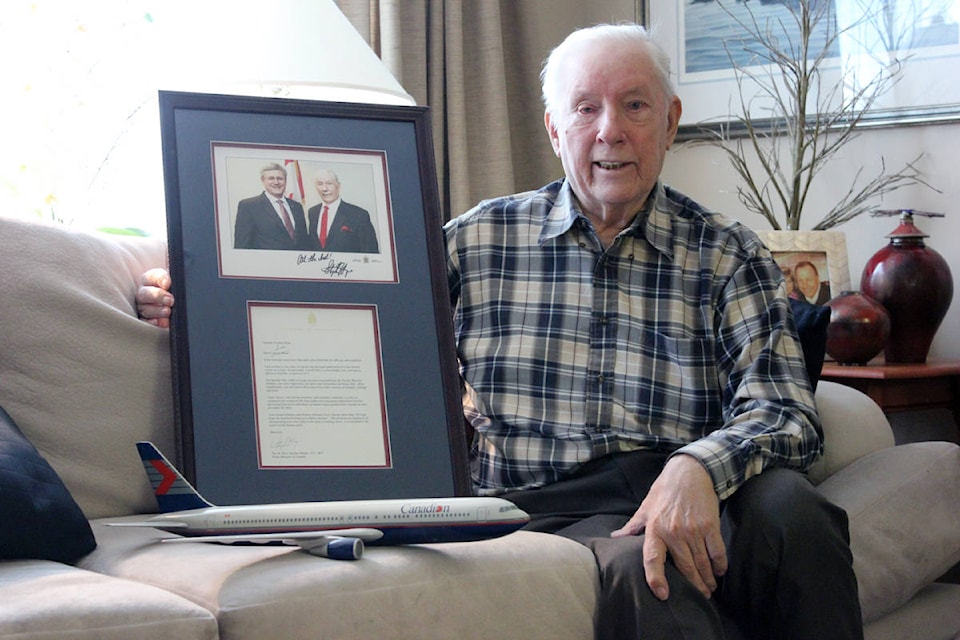It was April 1972 and Pacific Western Airlines captain Gord Moul was faced with a potentially fatal choice to make.
“I was being asked to play God,” said Moul, who now lives in Nanaimo.
At the time, Ugandan president Idi Amin had ordered roughly 80,000 people of South Asian descent, many of whom were British citizens, to leave Uganda, claiming that they were sabotaging the country’s economy and promoting corruption. As a result of Amin’s order, the Canadian government under Pierre Elliot Trudeau agreed to accept thousands of refugees from Uganda and hired Pacific Western Airlines, Air Canada and Canadian Pacific Air Lines to bring the refugees from Entebbe to Canada.
Moul, then 40, was one of Canada’s most experienced pilots and had completed multiple refugee flights out of Entebbe with few issues. As with his previous flights, Moul planned to leave the town by 8 a.m., fearing that a hot afternoon would cause engine problems for the Boeing 707. However, shortly after landing in Entebbe, it became clear that an early departure was unlikely once military police boarded the plane.
“Nobody could get off. They wouldn’t even let the engineer off to check the airplane,” Moul said. “We told them we had to leave immediately because of the rising temperature.”
The crew’s warning meant nothing to the Ugandan military, which spent hours searching, and in some cases killing, the more than 150 South Asian refugees waiting to board the aircraft, which remained in an increasingly hot hangar.
“The refugees were only allowed to take $25,000 out and if you violated that in any way, they just shot you,” Moul said. “If you tried to take anything out of the country other than what you were told you could take, there was no hearing, they just shot you.”
When the Boeing 707 was finally cleared to leave Entebbe hours later, the temperature outside was 45 degrees and 42 refugees had been killed by the Ugandan military.
“I knew what was going on in the hangar. One of my hobbies was shooting and I could hear the popping,” Moul recalled.
Moul now had to decide whether he should attempt to fly an overheated and overweight Boeing 707 loaded with refugees and risk crashing into nearby Lake Victoria, or offload at least 40 refugees, which likely would have resulted in their death, in an effort to make the plane lighter.
“I said ‘we may as well be a ball of junk at the end of the runway than dead at the hangar,’” Moul said.
As the Boeing 707 raced down toward the end of the runway, Moul realized it might not reach takeoff speed in time and had to make a decision.
“We had two choices, fly or go into the lake,” Moul said. “So, I just eased up on the control column and it ran along on the main wheels and then all of the sudden it was quiet and that meant the airplane was in the air.”
Moul said as the aircraft slowly climbed, it was doing so at a speed that should have resulted in an aerodynamic stall, but didn’t. He said the plane’s nose was so high the flight engineer had to stand up in order to see out the cockpit window and that they were barely flying above the water.
“The stall warning should have been going and the stick shaker should have been going,” he said. “We were sitting over the lake with the nose in the air below flying speed. We were 50 feet above the water and we were below stall speed.”
Fortunately for Moul and everyone on board, the plane managed to burn enough fuel while crossing the lake that it was able to gain more height, eventually reaching cruising altitude and Canada. Moul, who is the only crew member alive today, said the fact that the airplane even made it over Lake Victoria had nothing to do with his flying ability but was an act of God.
“To say that had something to do with me or my experience is bull because the airplane should not have been in the air,” he said.
Moul continued to fly for Pacific Western and then Canadian Airlines. He retired in 1991 with 33,343 hours of flying time to his name. In 2013, then-Prime Minister Stephen Harper recognized Moul’s Entebbe flight by presenting him with a special letter during the opening of Parliament.
“It’s a crazy story,” Moul said.
nicholas.pescod@nanaimobulletin.com
